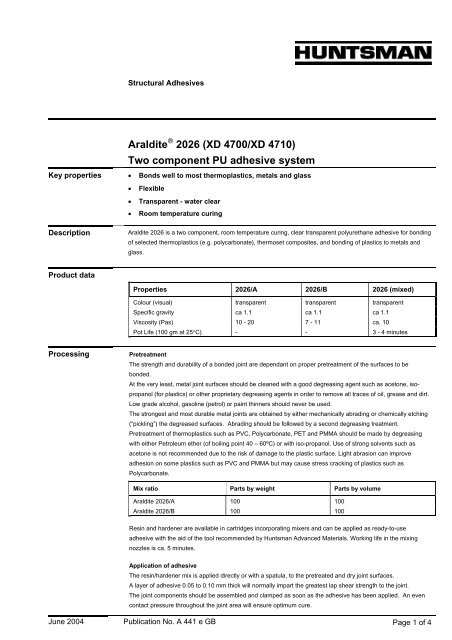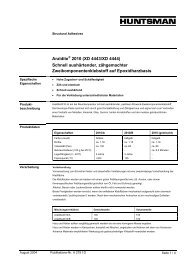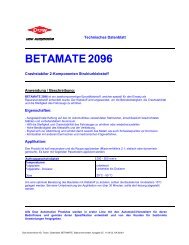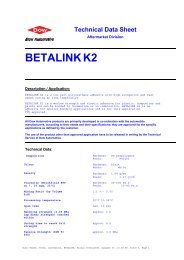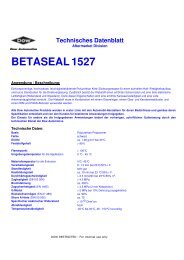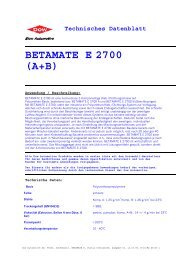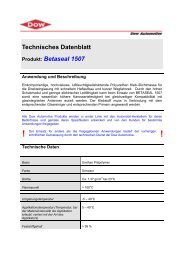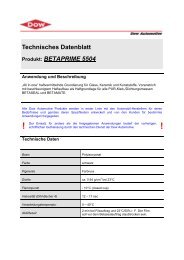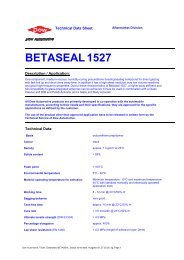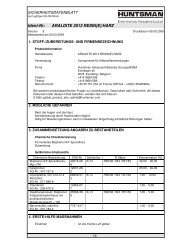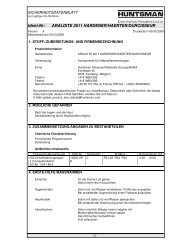Araldite 2026 (XD 4700/XD 4710) Two component PU ... - ECT
Araldite 2026 (XD 4700/XD 4710) Two component PU ... - ECT
Araldite 2026 (XD 4700/XD 4710) Two component PU ... - ECT
You also want an ePaper? Increase the reach of your titles
YUMPU automatically turns print PDFs into web optimized ePapers that Google loves.
Structural Adhesives<br />
<strong>Araldite</strong> ® <strong>2026</strong> (<strong>XD</strong> <strong>4700</strong>/<strong>XD</strong> <strong>4710</strong>)<br />
<strong>Two</strong> <strong>component</strong> <strong>PU</strong> adhesive system<br />
Key properties • Bonds well to most thermoplastics, metals and glass<br />
• Flexible<br />
• Transparent - water clear<br />
• Room temperature curing<br />
Description <strong>Araldite</strong> <strong>2026</strong> is a two <strong>component</strong>, room temperature curing, clear transparent polyurethane adhesive for bonding<br />
of selected thermoplastics (e.g. polycarbonate), thermoset composites, and bonding of plastics to metals and<br />
glass.<br />
Product data<br />
Properties <strong>2026</strong>/A <strong>2026</strong>/B <strong>2026</strong> (mixed)<br />
Colour (visual) transparent transparent transparent<br />
Specific gravity ca 1.1 ca 1.1 ca 1.1<br />
Viscosity (Pas) 10 - 20 7 - 11 ca. 10<br />
Pot Life (100 gm at 25°C) - - 3 - 4 minutes<br />
Processing Pretreatment<br />
The strength and durability of a bonded joint are dependant on proper pretreatment of the surfaces to be<br />
bonded.<br />
At the very least, metal joint surfaces should be cleaned with a good degreasing agent such as acetone, isopropanol<br />
(for plastics) or other proprietary degreasing agents in order to remove all traces of oil, grease and dirt.<br />
Low grade alcohol, gasoline (petrol) or paint thinners should never be used.<br />
The strongest and most durable metal joints are obtained by either mechanically abrading or chemically etching<br />
(“pickling”) the degreased surfaces. Abrading should be followed by a second degreasing treatment.<br />
Pretreatment of thermoplastics such as PVC, Polycarbonate, PET and PMMA should be made by degreasing<br />
with either Petroleum ether (of boiling point 40 – 60ºC) or with iso-propanol. Use of strong solvents such as<br />
acetone is not recommended due to the risk of damage to the plastic surface. Light abrasion can improve<br />
adhesion on some plastics such as PVC and PMMA but may cause stress cracking of plastics such as<br />
Polycarbonate.<br />
Mix ratio Parts by weight Parts by volume<br />
<strong>Araldite</strong> <strong>2026</strong>/A 100 100<br />
<strong>Araldite</strong> <strong>2026</strong>/B 100 100<br />
Resin and hardener are available in cartridges incorporating mixers and can be applied as ready-to-use<br />
adhesive with the aid of the tool recommended by Huntsman Advanced Materials. Working life in the mixing<br />
nozzles is ca. 5 minutes.<br />
Application of adhesive<br />
The resin/hardener mix is applied directly or with a spatula, to the pretreated and dry joint surfaces.<br />
A layer of adhesive 0.05 to 0.10 mm thick will normally impart the greatest lap shear strength to the joint.<br />
The joint <strong>component</strong>s should be assembled and clamped as soon as the adhesive has been applied. An even<br />
contact pressure throughout the joint area will ensure optimum cure.<br />
June 2004 Publication No. A 441 e GB Page 1 of 4
Typical cured<br />
properties<br />
Mechanical processing<br />
Specialist firms have developed metering, mixing and spreading equipment that enables the bulk processing of<br />
adhesive. We will be pleased to advise customers on the choice of equipment for their particular needs.<br />
Equipment maintenance<br />
All tools should be cleaned before adhesives residues have had time to cure. The removal of cured residues is a<br />
difficult and time-consuming operation.<br />
If solvents such as acetone are used for cleaning, operatives should take the appropriate precautions and, in<br />
addition, avoid skin and eye contact.<br />
Times to minimum shear strength<br />
Temperature °C 10 15 23 40 60 100<br />
Cure time to reach hours 4 2½ 1 - - -<br />
LSS > 1N/mm 2 minutes - - - 15 6 2<br />
Cure time to reach hours 60 15 8 4 - -<br />
LSS > 10N/mm 2 minutes - - - - 30 12<br />
LSS = Lap shear strength.<br />
Unless otherwise stated, the figures given below were all determined by testing standard specimens made by<br />
lap-jointing 170 x 25 x 1.5 mm strips of aluminium alloy. The joint area was 12.5 x 25 mm in each case.<br />
The figures were determined with typical production batches using standard testing methods. They are provided<br />
solely as technical information and do not constitute a product specification.<br />
Average lap shear strengths of typical metal-to-metal joints (ISO 4587)<br />
Cured for 16 hours at 40 o C and tested at 23°C<br />
Pretreatment - Sand blasting<br />
Aluminium<br />
Steel 37/11<br />
Stainless steel V4A<br />
Galvanised steel<br />
N/mm 2<br />
Copper<br />
Brass<br />
0 5 10 15 20 25<br />
Average lap shear strengths of typical non-metallic joints (ISO 4587)<br />
Cured for 16 hours at 40 o C and tested at 23°C<br />
Pretreatment - Lightly abrade and alcohol degrease. (glass – degreased only)<br />
SMC<br />
Polycarbonate<br />
ABS<br />
Acrylic<br />
GRP<br />
GRE<br />
Polyamide(nylon6)<br />
N/mm 2<br />
Glass<br />
* denotes substrate failure.<br />
0 5 10 15 20 25<br />
June 2004 Publication No. A 441 e GB Page 2 of 4<br />
*<br />
*<br />
*<br />
*
Lap shear strength versus temperature (ISO 4587) (typical average values)<br />
Cure: (a) = 7 days /23°C; (b) = 24 hours/23°C + 30 minutes/80°C<br />
°C<br />
N/mm 2<br />
40<br />
30<br />
20<br />
10<br />
0<br />
Roller peel test (ISO 4578)<br />
Cured 16 hours/40°C<br />
Elongation at break at 23°C<br />
Tensile strength at 23°C (ISO R527)<br />
E-modulus<br />
b<br />
a<br />
-50 -30 -20 0 20 40 60 80 100<br />
Glass transition temperature<br />
8.0 N/mm<br />
June 2004 Publication No. A 441 e GB Page 3 of 4<br />
50%<br />
18 MPa<br />
200 MPa<br />
ca. 20°C<br />
Lap shear strength versus immersion in various media (typical average values)<br />
Unless otherwise stated, L.S.S. was determined after immersion for 90 days at 23°C<br />
As-made value<br />
IMS<br />
Gasoline (petrol)<br />
Ethyl acetate<br />
Acetic acid, 10%<br />
Xylene<br />
Lubricating oil<br />
Paraffin<br />
Water at 23°C<br />
Water at 60°C<br />
Water at 90°C<br />
N/mm 2<br />
30 days 60 days 90 days Cure: 16 hours/40°C<br />
0 5 10 15 20 25<br />
Lap shear strength versus tropical weathering<br />
(40/92, DIN 50015; typical average values) Cure: 16 hours/40 o C; Test: at 23 o C<br />
On Aluminium – degreased and sandblasted<br />
As made value<br />
After 30 days<br />
After 60 days<br />
After 90 days<br />
N/mm 2<br />
0 5 10 15 20 25
On Polycarbonate – Isopropanol degreased<br />
Lap shear strength versus heat ageing, Cure: 16 hours/40°C<br />
On Aluminium – degreased and sandblasted<br />
Thermal cycling<br />
100 cycles of 6 hour duration from -30°C to 70°C: 18 N/mm 2<br />
Shear modulus (G’) DIN 53345<br />
-50°C<br />
1GPa<br />
0°C<br />
0.8GPa<br />
20°C<br />
0.6GPa<br />
40°C<br />
0.2GPa<br />
60°C<br />
10MPa<br />
Flexural Properties (ISO 178) Cure 16 hours/ 40ºC tested at 23ºC<br />
Flexural Strength 5.5 MPa<br />
Flexural Modulus 274.2 MPa<br />
Storage <strong>Araldite</strong> <strong>2026</strong>/A and <strong>Araldite</strong> <strong>2026</strong>/B may be stored at 2-40ºC provided the <strong>component</strong>s are stored in sealed<br />
containers. The expiry date is indicated on the label. Cartridges should not be stored for long periods after<br />
removal from the foil overpack.<br />
Handling<br />
precautions<br />
Huntsman Advanced<br />
Materials<br />
Duxford, Cambridge<br />
England CB2 4QA<br />
Tel: +44 (0) 1223 832121<br />
Fax: +44 (0) 1223 493322<br />
www.araldite.com<br />
As made value<br />
After 30 days<br />
After 60 days<br />
After 90 days<br />
N/mm 2<br />
As made value<br />
30 days / 70ºC<br />
60 days / 70ºC<br />
90 days / 70ºC<br />
N/mm 2<br />
0 5 10<br />
0 5 10 15 20 25 30<br />
Caution<br />
Our products are generally quite harmless to handle provided that certain precautions normally taken when<br />
handling chemicals are observed. The uncured materials must not, for instance, be allowed to come into contact<br />
with foodstuffs or food utensils, and measures should be taken to prevent the uncured materials from coming in<br />
contact with the skin, since people with particularly sensitive skin may be affected. The wearing of impervious<br />
rubber or plastic gloves will normally be necessary; likewise the use of eye protection. The skin should be<br />
thoroughly cleansed at the end of each working period by washing with soap and warm water. The use of<br />
solvents is to be avoided. Disposable paper - not cloth towels - should be used to dry the skin. Adequate<br />
ventilation of the working area is recommended. These precautions are described in greater detail in the<br />
Material Safety Data sheets for the individual products and should be referred to for fuller information.<br />
All recommendations for the use of our products, whether given by us in writing, verbally, or to be implied from the results of<br />
tests carried out by us, are based on the current state of our knowledge. Notwithstanding any such recommendations the Buyer<br />
shall remain responsible for satisfying himself that the products as supplied by us are suitable for his intended process or<br />
purpose. Since we cannot control the application, use or processing of the products, we cannot accept responsibility therefor.<br />
The Buyer shall ensure that the intended use of the products will not infringe any third party’s intellectual property rights. We<br />
warrant that our products are free from defects in accordance with and subject to our general conditions of supply.<br />
© 2004 Huntsman Advanced Materials (Switzerland) GmbH<br />
® <strong>Araldite</strong> is a registered trademark of Huntsman LLC or an affiliate thereof in one or more, but not all, countries.<br />
June 2004 Publication No. A 441 e GB Page 4 of 4


